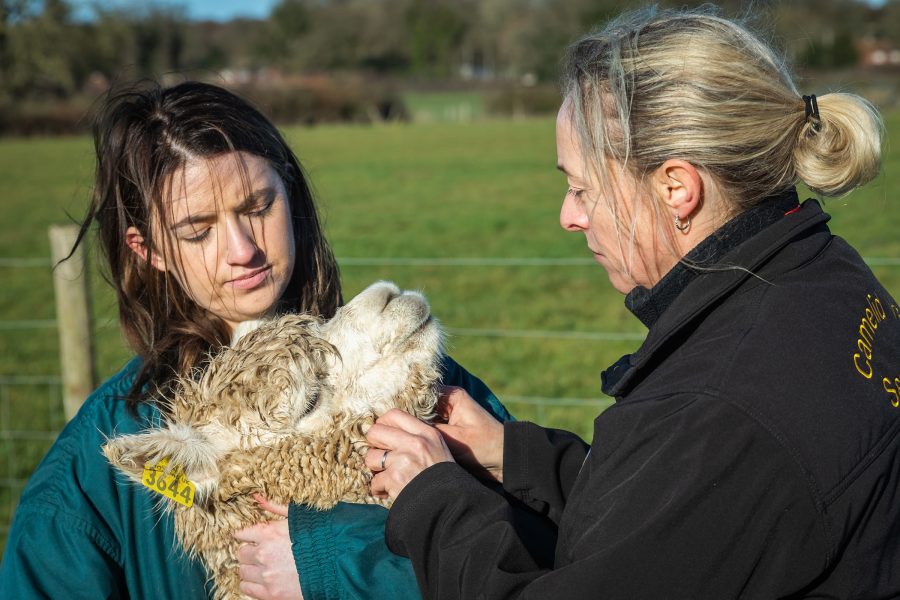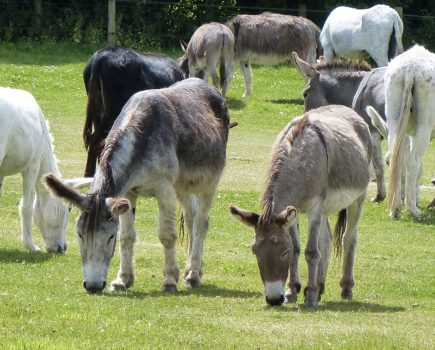Camelid specialist, Claire Whitehead, explores the causes of weight loss in camelids, and what can be done to remedy this common issue.
Weight loss is a common and concerning issue in camelids, with a variety of potential causes. Addressing it effectively requires identifying the underlying problem, as the causes can range from poor nutrition to chronic disease. While diagnosing the exact issue often involves veterinary expertise, there are steps you, as an owner, can take to get started and gather valuable information.
START WITH THE BASICS
Some of the most common causes of weight loss are straightforward to check. Begin by evaluating the animal’s body condition and performing a thorough visual and physical assessment:
- Examine the teeth:
• Check for overgrown incisors or sharp points on the cheek teeth that could cause oral pain. Don’t put your fingers in your alpaca’s mouth because they have very sharp teeth!
• Feel along the jawline for swellings, which may indicate a tooth root abscess. - Rule out parasites
• Collect a fresh faecal sample to test for worms, coccidia (particularly Eimeria macusaniensis), and fluke if it’s a concern in your area.
• Make sure you send your faecal samples to a lab that is familiar with alpacas and is performing the most sensitive testing methods so that things aren’t missed. We perform the Modified Stolls test at our lab and you can send your samples directly to us for fast efficient reporting. You will be provided with a full and detailed interpretation helping you and your vet manage your herd’s health. For more details, visit www.ukalpacavet.com. - Observe behaviour
• Watch how the animal interacts at feeding time. Is it being pushed away by dominant herd members? If so, consider providing separate feeding areas - Evaluate Nutrition
Assess the quality of your forage and pasture. Pregnant, lactating, or growing animals often require higher protein and energy levels than poor-quality forage can provide. If in doubt about the quality of your forage, consider supplementing with tested, high-quality feeds like chopped dried grass or alfalfa. Avoid excessive reliance on concentrates, as these can disrupt digestion if not properly balanced.
WHEN TO CALL YOUR VET
If weight loss is significant, the animal isn’t eating, or basic checks don’t reveal an obvious cause, it’s time to involve your veterinarian. A vet can perform a detailed clinical examination and advanced diagnostics, such as:
- Bloodwork: A full panel (including haematology, biochemistry, and mineral levels) can pinpoint systemic diseases, chronic inflammation, or nutritional imbalances.
- Imaging: Ultrasound can detect internal issues like abscesses, tumours, or organ enlargement. For example, thoracic ultrasonography is particularly useful for diagnosing tuberculosis in camelids showing weight loss and respiratory symptoms.
FEEDING FOR RECOVERY
Once the underlying cause is addressed, reversing weight loss involves providing high-quality nutrition. You should ensure that the forage you’re providing is of excellent quality – check this using forage testing. A number of companies sell chopped dried grass with a consistent nutritional profile and this can be a reliable option to provide good quality and palatable forage to animals with special needs. Add supplements such as sugarbeet for energy and alfalfa for protein, but always introduce new feeds gradually over 7–10 days to prevent upsetting the delicate microbial balance in the first stomach compartment. Consider adding a probiotic to promote growth of the microbes in the first stomach compartment. This must be a probiotic designed for ruminants rather than one that is appropriate for simple-stomached animals such as horses, humans or small animals.
EMPOWER YOURSELF
Dealing with weight loss in alpacas can be daunting, but your proactive involvement in these cases is crucial. By performing simple observations and tests, you can provide your veterinarian with valuable insights that expedite diagnosis in these cases and allow effective treatment from the outset. Remember, you’re not alone — your vet is there to guide you through more complex cases. With careful management and professional support, most animals can recover and thrive once their underlying issues are addressed. If your vet needs assistance with any alpaca cases, please consider booking a consultation with me. It’s always best if you and your vet are involved in this consultation process.
FREE RESOURCES
If you’re not sure how to body condition score or need a refresher, please check out the free resources on my website where you’ll find a video and downloadable handout on the topic. You’ll also find other FREE helpful resources here such as how to check for anaemia, toenail trimming, vitamin D supplementation, feeding crias and using plasma in crias. www.ukalpacavet.com/resources/
 ABOUT CLAIRE WHITEHEAD
ABOUT CLAIRE WHITEHEAD
Dr Claire Whitehead has been working with camelids for 35years, having started learning all about them on the family farm, and then choosing to specialise in them after becoming a vet in 1999. She completed a 3-year camelid-specific medicine residency programme in the US, the first of its kind outside South America and then returned to the UK. She set up the Camelid & Farm Animal Hospital service at the Royal Veterinary College and then set up a camelid-only referral and consultancy practice in Oxfordshire where she is happy to help anyone with the camelid care concerns, as referrals or in consultation with you and your vet! She has been teaching both owners and vets how to work with camelids since 2003, and offers a variety of on-demand training options for owners and vets. She was recognised as the first (and remains the only) RCVS Specialist in Camelid Health & Production in early 2016 and has been President of the British Veterinary Camelid Society since 2011. Claire has contributed to veterinary texts in camelid medicine and is going to release her new book in April 2025 – The Camelid Care Handbook for Alpaca & Llama Owners. www.ukalpacavet.com/
This article was taken from the February 2025 edition of The Country Smallholder. You can buy the issue here.








